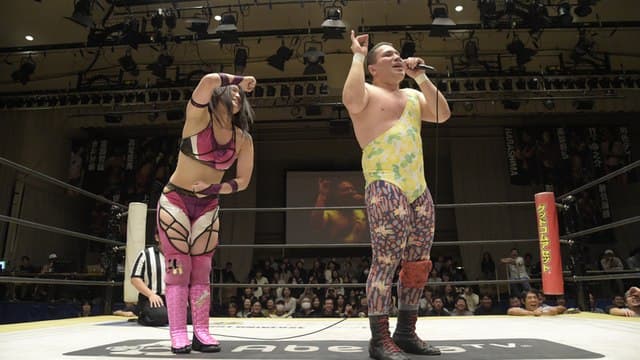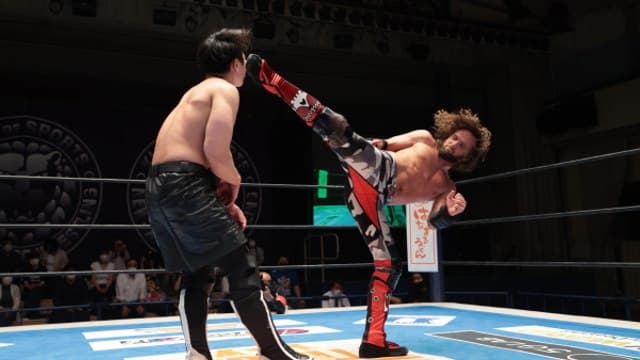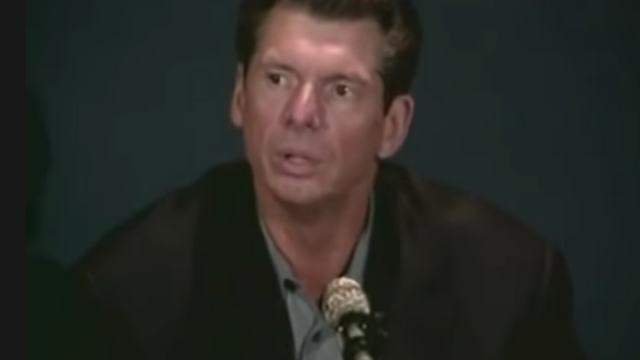In the distant past of a few weeks ago, when things like sports and being able to engage in the outside world still existed in many parts of the globe, Japanese wrestling promotions like NJPW and DDT started cancelling their first wave of shows in response to the COVID-19 situation. It was the right choice, and not an entirely shocking development if you’d been following the news at all. But it was still a disappointment and, I suspect, a fresh one for at least some wrestling fans. It was a harbinger of the doom that was quickly coming, but not yet a daily, numbing reality. And, for me, an unnerving change in my primary source of distraction from what scares and ails me.
In the midst of this looming dread and chaos, though, there was a touch of mildly alleviating news: during the downtime, most of these promotions would be offering some sort of audience-free alternative. NJPW put together a series of talk shows that enabled Toru Yano to continue his CHAOS Academy teachings, Golden☆Ace to flex, and Hiromu Takahashi to Hiromu. Stardom streamed No People Gate, an empty Korakuen Hall show as entertaining as its name, live on YouTube. And DDT assembled a collection of dojo shows and fan outreach programming that far exceeded my already high expectations for all things Dramatic Dream Team.

DDT were uniquely well-equipped to adapt to the situation.
They’ve aired live shows and press conferences out of their small dojo space many times before. Their talent and production crew have gained all sorts of experience in the art of staging compelling crowd-free wrestling thanks to the promotion’s bonkers street wrestling odysseys. (The most famous of these is Sanshiro Takagi and Minoru Suzuki’s empty arena Tokyo Dome match from 2017, which is streaming for free until the end of the month. But there are some great lesser known gems in this genre, too. Like Takagi running through a series of opponents for an audience of one in the Hokkaido Nosappu Aurora Tower parking lot.) The fluid nature of DDT’s fourth wall also gives its wrestlers more freedom to acknowledge — and run with — the logistical and creative challenges of performing in less than ideal conditions than more traditional wrestling can accommodate. But it was still impressive how quickly and how cleverly everyone involved adapted to their setting and circumstances. And then embraced them.
This wasn’t a simple case of “the show must go on.” It was more like “the show’s dead, let’s see what cool shit we can get up to!” The new approach was first evident in the little details, like the lack of audience participation becoming fodder for a number of angles and running gags. Maki Itoh collapsed into tears when her classic “Who’s the cutest in the world?” taunt was met with silence at the first Tokyo Joshi Pro dojo show, which allowed her confused opponent to escape unharmed. Within a few matches, though, she was slapping herself out of her momentary sobs and answering her own question. A few matches later, Mina Shirakawa’s call for the crowd faded into a perfectly timed awkward pause before she refocused on wrestling. Her teammates doubled as her cheering section to help propel her through the second show. HARASHIMA listened to a canned audience through headphones to help keep his spirits high. The newly swordless Daisuke Sasaki, on the other hand, changed absolutely nothing and spent a lot of time posing for blank walls. He did make a plea to save Corona beer in these troubled times, though. (The exceedingly functional and wise Charisma also solicited life advice live on YouTube for a show called Daisuke Sasaki’s Life Is Beautiful.)
More Pro Wrestling:
- 2019 in Wrestling: The Universal Comedy of a DDT Campsite Match
- Celebrate International Women’s Day on Classic Joshi YouTube
- Gatoh Move’s Lulu Pencil is Important Freelance Writer Representation
The extended time away from live audiences appeared to lend itself to some experimentation with staging and film as time went on, too. Things got especially avant garde when Danshoku Dieno took over filming during one of his matches. I’m still ambivalent about the actual content of that segment, but I thought the cinematography was audacious, original, and daring. Ganbare streamed an experimental match with a barebones crew of four — including the wrestlers — live on Twitter. Even some of the more straightforward matches seemed to benefit from the dojo setting. HARASHIMA and Shunma Katsumata’s barefoot LEGO match would have been a minor classic in any venue, but the dojo show camera work conveyed a level of immediacy and abject horror that might not have reached a live audience a few rows away from the gleefully wincing action.

Even the DDT merch drive created in response to the cancellations has been ingenious.
With in-person sales, autographs, and photos off the table for an extended period of time, DDT did their best to keep fans feeling connected and spending money. A whole slew of autographed portraits — including a lovely shot of one of Tetsuya Endo’s pet beetles — were made available for online purchase, you could also purchase spins from the Dramatic Dream Gatcha or draws from the Dramatic Lottery, and choose which wrestler you’d prefer to pick for you. Orders even came with photographic evidence of this selection. (I requested Damnation’s pet alien son Mad Paulie. He did a very good job.) And, in a stroke of absolute genius, Tokyo Joshi Pro’s stars hosted a series of no-people autograph sessions live on YouTube.
In theory, DDT is supposed to return to live audiences this week. I have no idea if this will happen or not. I’m not even sure how long efforts like the ones listed above are going to be sustainable in terms of health, finances, or morale in any parts of the world. But I’m glad to have had them for as long as I did. Both for the welcome distraction and for the reminder that sometimes, just sometimes, new and exciting things can emerge from disappointment and destruction.


